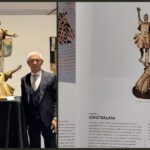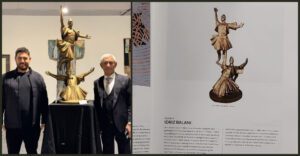Washington welcomes millions of American and foreign visitors every year. In many cases, tourists engage a guide who explains the history of the American capital and accompanies them to some of the most famous landmarks. One of these tour guides in Washington is the Albanian-American Istref Haxhosaj, who has been in this profession since 2013. He shared with us some of his favorite spots to visit in Washington.
At the Marine Corps War Memorial in Arlington, Virginia, stands one of the most iconic American statues: the marines raising the flag on the Japanese island of Iwo Jima during World War II, a work that honors all American marines who gave their lives for the country.
Albanian-American Istref Haxhosaj, a tour guide in Washington, says he usually starts his tours with visitors from here.
“Because this has great significance for the freedom of America and the entire world. American soldiers have fought for freedom. American marines and all other American soldiers have never stopped fighting for freedom. It is very important to start here because here begins our well-being and freedom as a people” says Mr. Haxhosaj to Voice of America.
Mr. Haxhosaj came to the United States a few years after the end of the war in Kosovo and became part of the tourism industry in 2013.
For more than a decade, he says he has had over 4,000 private groups of tourists. Mr. Haxhosaj says that in his explanations he always emphasizes the connection between the United States and Kosovo.
“I tell Americans where I come from and who I am. I tell Americans that I am here today because of the intervention of American soldiers in 1999, otherwise, I wouldn’t be here, or I wouldn’t be alive. I tell them that the survival of the people of Kosovo and the Albanians in the Balkans is directly linked to the American intervention. So I tell Americans a story that very few know about the intervention in Kosovo. I came from a small country with very limited opportunities. I could barely speak English when I came here. I could understand, read, and write, but very little. In America, the opportunities were limitless. I was given the opportunity to go to college, I was given the opportunity to work, I did various jobs until I started this profession. This is the second thing I tell Americans, especially the young ones, because most of them take life in America for granted” says Mr. Haxhosaj.
Mr. Haxhosaj says that his knowledge of American history does not only come from school.
“But also from living here. Because the history of America is in every street of Washington, every building, so my passion grows every day here” he adds.
One of Mr. Haxhosaj’s favorite stops is the National Cathedral in Washington, whose construction began in 1907 and whose Gothic-style structure was inaugurated in the early 1990s.
“The National Cathedral is all-inclusive. It started as Episcopal, which is a branch of Christianity, but now it is all-inclusive. This also shows religious tolerance and freedom of expression in the USA. When 9/11 happened, this church was open to everyone. When an attack happened in a mosque in New Zealand, where several Muslims were killed, this was open to all Muslims. When there was an attack on a synagogue in Pittsburgh in America, this was open to all Jews” says guide Haxhosaj.
This cathedral also houses the tomb of the 28th American president.
“Here we are near the tomb of one of the most beloved American presidents, Woodrow Wilson. He was president during the early 1900s, during World War I. He was a man who believed in small democratic nations, including Albania. Near President Wilson’s tomb is also the seal of the American president, which has the single-headed eagle and the Latin phrase ‘e pluribus unum,’ which means out of 50 states, six territories, and people from all over the world, the American state is one nation” says Mr. Haxhosaj.
The residence of the American presidents is one of the most famous tourist spots in Washington, with nearly 890,000 visitors last year. Mr. Haxhosaj talks about the impressions of visitors after seeing the White House.
“Usually, people when they come here focus on the size of the White House. Many of them think that presidents should have a very large house and are often disappointed because it doesn’t seem big enough. But the idea of democracy, the idea of America, has been that this is not only the president’s house but the house of the American people. So the focus was not on the individual but on democratic institutions. The idea was to be simple and beautiful” says Mr. Haxhosaj.
Another important stop in the capital, according to Mr. Haxhosaj, is the National Archives building, where the most important documents that laid the foundations of the United States are kept.
“This building was completed in 1935. Every important American document ends up in the public archive here. Important documents are kept here. One of them is the NATO document, inside you can find a copy of the Declaration of Independence from 1776, a copy of the Bill of Rights, which was America’s first constitution, and also the U.S. Constitution itself” explains Mr. Haxhosaj.
The Capitol Building, the Washington Monument, the Lincoln Memorial, the World War II Memorial, and the Smithsonian museum complex are also on the list of main points for visitors to the capital.
Last year, Washington hosted nearly 25 million visitors, 17 percent more compared to 2022./VOA








